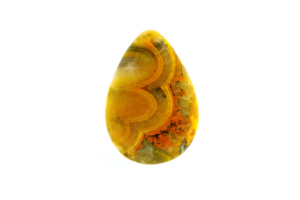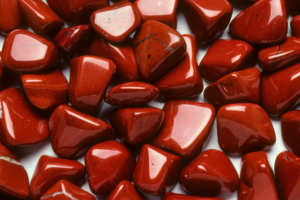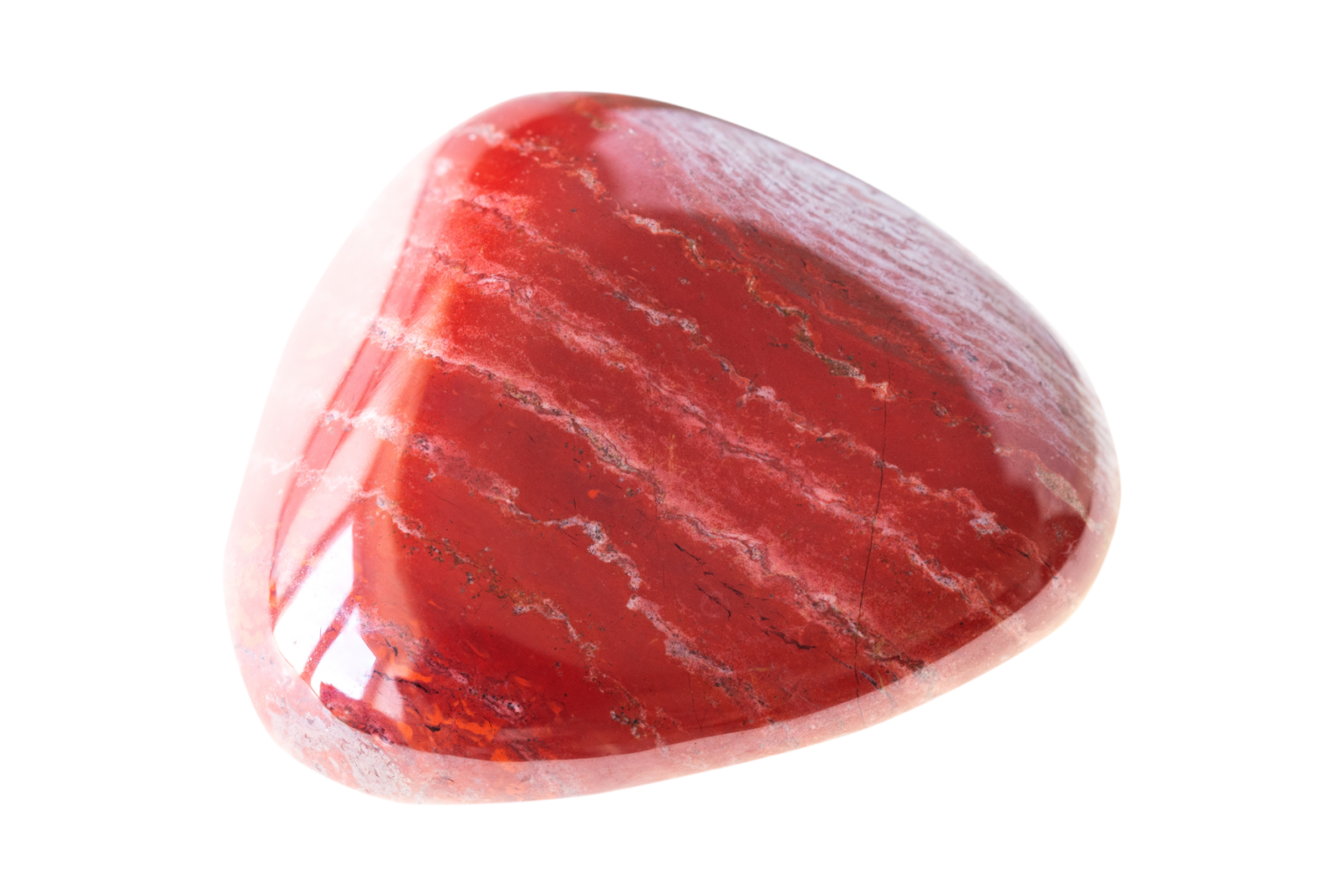What is Jasper?
Jasper is a form of chalcedony, which is a type of mineral in the quartz family. It is a microcrystalline variety of quartz, which means that it is made up of very small crystals that are too small to see with the naked eye. Jasper is typically opaque, meaning that light cannot pass through it.
Jasper comes in a wide variety of colors, patterns, and textures, and each type of jasper has its own unique qualities and properties. Some of the most common colors of jasper include red, yellow, green, brown, and grey. Jasper can also have patterns or markings, such as stripes, spots, or swirls.
Jasper has been used for thousands of years for its beauty and durability. It has been used in jewelry, carvings, and other decorative objects, as well as for practical purposes such as tools and weapons. Jasper is also believed to have various spiritual and healing properties in many cultures and belief systems.
How is jasper formed?
Jasper is formed through a process of volcanic activity, sedimentation, and mineralization.
It is formed when silica-rich fluids seep into the cracks and cavities of rocks and sedimentary materials, and then crystallize over time. These fluids may come from volcanic activity or from the surrounding sedimentary rock.
As the silica-rich fluids solidify, they form microcrystalline quartz, which gives jasper its characteristic smooth and polished appearance. The colors and patterns of jasper are often the result of impurities and other minerals that are present in the surrounding rock and sediment.
Over time, jasper may become buried and subjected to heat and pressure, which can cause it to undergo metamorphism and change in color or texture. Jasper can also be weathered and eroded over time, exposing it to the surface and creating new specimens for collection.
Jasper can be found in many parts of the world, including the United States, Russia, Australia, Brazil, and Madagascar.
What are the different types of jasper stones?

Jasper comes in a wide variety of colors, patterns, and textures, and each type of jasper has its own unique qualities and properties. Some of the most common types of jasper include:
- Red jasper – a deep red stone that is often used for grounding and protection.
- Picture jasper – a stone with unique patterns that resemble landscapes or pictures, often used for grounding and creativity.
- Dalmatian jasper – a stone with black spots on a white or beige background, often used for fun and playfulness.
- Ocean jasper – a stone with circular patterns in shades of green, blue, and white, often used for emotional healing and stress relief.
- Brecciated jasper – a stone with broken fragments of jasper in a matrix of other minerals, often used for grounding and stability.
- Bumblebee Jasper- a unique type of stone that is characterized by its striking yellow, orange, and black banding. It is a combination of volcanic matter and sedimentary rock.
These are just a few examples of the many different types of jasper that are available. Each type of jasper has its own unique properties and can be used for a variety of purposes, depending on what you need in your life.
What does each color symbolize?
Jasper comes in a wide variety of colors, patterns, and textures, and each type of jasper has its own unique qualities and properties. Some of the most common types of jasper include:
- Red jasper – a deep red stone that is often used for grounding and protection.
- Picture jasper – a stone with unique patterns that resemble landscapes or pictures, often used for grounding and creativity.
- Dalmatian jasper – a stone with black spots on a white or beige background, often used for fun and playfulness.
- Ocean jasper – a stone with circular patterns in shades of green, blue, and white, often used for emotional healing and stress relief.
- Brecciated jasper – a stone with broken fragments of jasper in a matrix of other minerals, often used for grounding and stability.
These are just a few examples of the many different types of jasper that are available. Each type of jasper has its own unique properties and can be used for a variety of purposes, depending on what you need in your life.

What chakras are associated with jasper?
Jasper is believed by some to be associated with multiple chakras, depending on the color and type of the stone. Chakras are energy centers in the body that are believed to correspond to different physical, emotional, and spiritual aspects of a person’s being.
Here are some examples of the chakras that different types of jasper are believed to be associated with:
- Red jasper: This stone is often associated with the root chakra, which is located at the base of the spine. The root chakra is associated with grounding, stability, and survival instincts.
- Yellow jasper: This stone is often associated with the solar plexus chakra, which is located in the upper abdomen. The solar plexus chakra is associated with personal power, self-confidence, and inner strength.
- Green jasper: This stone is often associated with the heart chakra, which is located in the center of the chest. The heart chakra is associated with love, compassion, and emotional balance.
- Picture jasper: This stone is often associated with the third eye chakra, which is located in the center of the forehead. The third eye chakra is associated with intuition, inner wisdom, and spiritual insight.
The Emotional Properties of Jasper
- Calming and grounding: Jasper is believed to have a calming and grounding energy that can help to reduce stress, anxiety, and other negative emotions. It is thought to promote a sense of peace and inner strength.
- Nurturing and supportive: Jasper is also believed to have a nurturing and supportive energy that can help to provide comfort and emotional stability during times of difficulty or change.
- Confidence and self-esteem: Some types of jasper are believed to have properties that can help to boost self-confidence and self-esteem. This can help to promote a sense of personal power and inner strength.
- Creativity and inspiration: Jasper is believed to have properties that can stimulate creativity and inspiration, and help to overcome creative blocks.
- Joy and playfulness: Some types of jasper, such as Dalmatian jasper, are believed to have properties that can promote a sense of joy, playfulness, and childlike wonder.
The Spiritual Properties of Jasper
- Connection to earth and nature: Jasper is believed to have a strong connection to the earth and the natural world. It is thought to help with grounding and connecting to the energies of the natural world.
- Inner journeying and insight: Jasper is believed to have properties that can promote inner journeying and insight, and help to access deeper levels of understanding and wisdom.
- Protection and cleansing: Jasper is believed to have protective and cleansing properties that can help to purify and protect the aura and energy field. It is thought to help remove negative energies and protect against psychic attacks.
- Spiritual growth and transformation: Some types of jasper, such as picture jasper, are believed to have properties that can support spiritual growth and transformation. It is thought to help with inner work, meditation, and connection to higher consciousness.
- Balance and harmony: Jasper is believed to have properties that can promote balance and harmony, both within oneself and in the external environment. It is thought to help balance the chakras and energy centers of the body, and promote a sense of overall well-being.

Red Jasper
Jasper’s History
Jasper has a long and fascinating history that spans thousands of years and multiple cultures around the world. Here are some key highlights from the history of jasper:
- Ancient Egypt: Jasper was highly valued in ancient Egypt, where it was used for amulets, jewelry, and other decorative objects. It was believed to have protective properties and was often inscribed with magical symbols and hieroglyphs.
- Ancient Greece and Rome: Jasper was also highly valued in ancient Greece and Rome, where it was used for carving cameos, intaglios, and other decorative objects. It was believed to have healing properties and was often used in medicine and as an antidote for poison.
- Native American cultures: Jasper was used by many Native American cultures for its spiritual and healing properties. It was often used in ceremonies, as well as for jewelry and other decorative objects.
- Medieval Europe: Jasper was highly valued in medieval Europe, where it was used for carving seals, talismans, and other decorative objects. It was believed to have protective properties and was often associated with royalty and nobility.
- Modern times: Jasper remains a popular material for jewelry, carvings, and other decorative objects today. It is valued for its beauty, durability, and unique patterns and colors.
Throughout its history, jasper has been associated with a wide range of beliefs and properties, including protection, healing, spiritual growth, and creativity. These beliefs and associations have evolved over time and vary depending on the culture, tradition, or spiritual practice.
Harnessing Jasper’s Energy
There are many ways to harness the energy of jasper, depending on your personal preferences and intentions. Here are some examples:
- Wearing jasper jewelry: Wearing jasper jewelry, such as a jasper necklace, bracelet, or earrings, can help to keep the energy of the stone close to your body and enhance its properties.
- Carrying a jasper stone: Carrying a small jasper stone in your pocket or purse can help to keep its energy with you throughout the day.
- Placing jasper in your environment: Placing jasper stones in your home or work environment can help to enhance the energy of the space and promote a sense of balance and harmony.
- Meditating with jasper: Meditating with jasper can help to enhance its spiritual properties and promote inner peace and clarity. You can hold a jasper stone in your hand or place it on your third eye or heart chakra during meditation.
- Using jasper in crystal grids: Jasper can be used in crystal grids, which are arrangements of crystals that are designed to amplify their energy and promote specific intentions. You can place jasper along with other crystals in a grid pattern that resonates with your goals or intentions.
- Using jasper in healing practices: Jasper can be used in various healing practices, such as crystal healing or Reiki. A practitioner may place jasper stones on specific areas of the body to promote healing and balance.
Summary
Jasper is a type of chalcedony, which is a microcrystalline form of quartz that is often opaque and comes in a wide variety of colors and patterns. It is formed through a process of volcanic activity, sedimentation, and mineralization, and has been used for thousands of years for its beauty and durability. Jasper is also believed by some to have physical, emotional, and spiritual properties that can promote well-being and balance. It can be harnessed in various ways, such as wearing jasper jewelry, carrying a jasper stone, meditating with jasper, and using jasper in healing practices.

